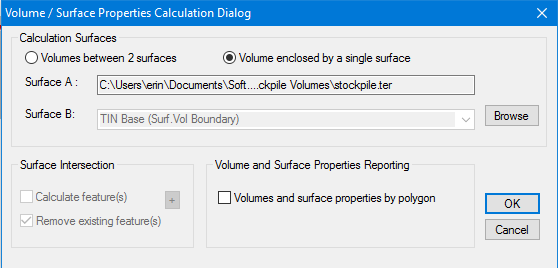

- #Stockpile measurement calculator how to
- #Stockpile measurement calculator full
- #Stockpile measurement calculator series
Let’s go to the Home icon, and from here, I’ll choose Export. Now that I’ve isolated these points, I’d like to export them as a brand new point cloud. I will then move my cursor back into the interface.

I’m going to hover over Unassigned Points, and then I’ll click the Hide toggle to hide their display on screen. I’m more interested in the points that are not part of this region.

Note there’s icons here, we can adjust the color of the display, we can lock the region, we can turn the region on and off, or we could delete the region. Right here, we can see the stockpile region I just created. In this popup menu, I can click to expand and view the regions in this point cloud. Now that I have this region, I can hover here in the lower right corner of the interface. We’ll call this region stockpile, and I’ll click okay. I can do that by coming down to the Region area, and I’ll select New Region. Now that the points are selected, I would like to place them in their own region. We can always come back and edit this selection later if we wanted to. I’m going to do this quickly in this case. I can then pick points going around the base of this stockpile. To select the points representing the stock pile, I’m going to come down to the selection area, and I’ll choose Fence. I’ll do that by clicking the top hotspot on the view cube. To calculate the volume of this large stockpile, I am first going to separate it from the other points in this dataset.

I should also mention that this stockpile is located in Missouri and when this data was processed, it was processed using the Missouri State Plane Coordinate System NAD83, Central Zone, US Foot.
#Stockpile measurement calculator full
Now in the interest of full disclosure, I should mention that this point cloud was created from drone imagery that was processed using ReCap Photo. If I hold the mouse wheel down, I can pan, if I hold the right mouse button down, I can orbit, and if I roll the mouse wheel forward and back, I can zoom in and out. Once the point cloud is open in the interface, we’ll talk a little bit about navigating. I’ll jump into this directory called point cloud, rcs, and I’ll select this point cloud called mesh.rcp. I’ll do that by clicking the Open button, and then I’m going to navigate into the dataset folder. As you can see, we’re starting out here in ReCap Pro.
#Stockpile measurement calculator how to
I am currently attempting to calculate an approximate measurement for the volume lost around the sides of the stockpile.In this session, we’ll look at how to use Civil 3D to calculate a stockpile volume from point cloud data. There is lost volume on the top (from around the cones – see diagram) and around the sides of the stockpile in areas around the cones. The angle of repose (the angle that the ore settles to the horizontal) of the ore is also known, as is the maximum stockpile height.Īn ‘ideal’ stockpile would have a flat top and sides.It is demonstrated in the attached diagrams that due to the nature of cone-ply stacking, this is not the case. The stockpile has a limited width and length. The aim is to maximise the capacity of the stockpile, within a given space.
#Stockpile measurement calculator series
I am in desperate need of some help with a materials handling problem which i am stumped on more specifically on calculating the volume of a stockpile that is built from a series of cones ('cone-ply')Ī cone-ply built stockpile is built with a series of cones (see diagram).


 0 kommentar(er)
0 kommentar(er)
